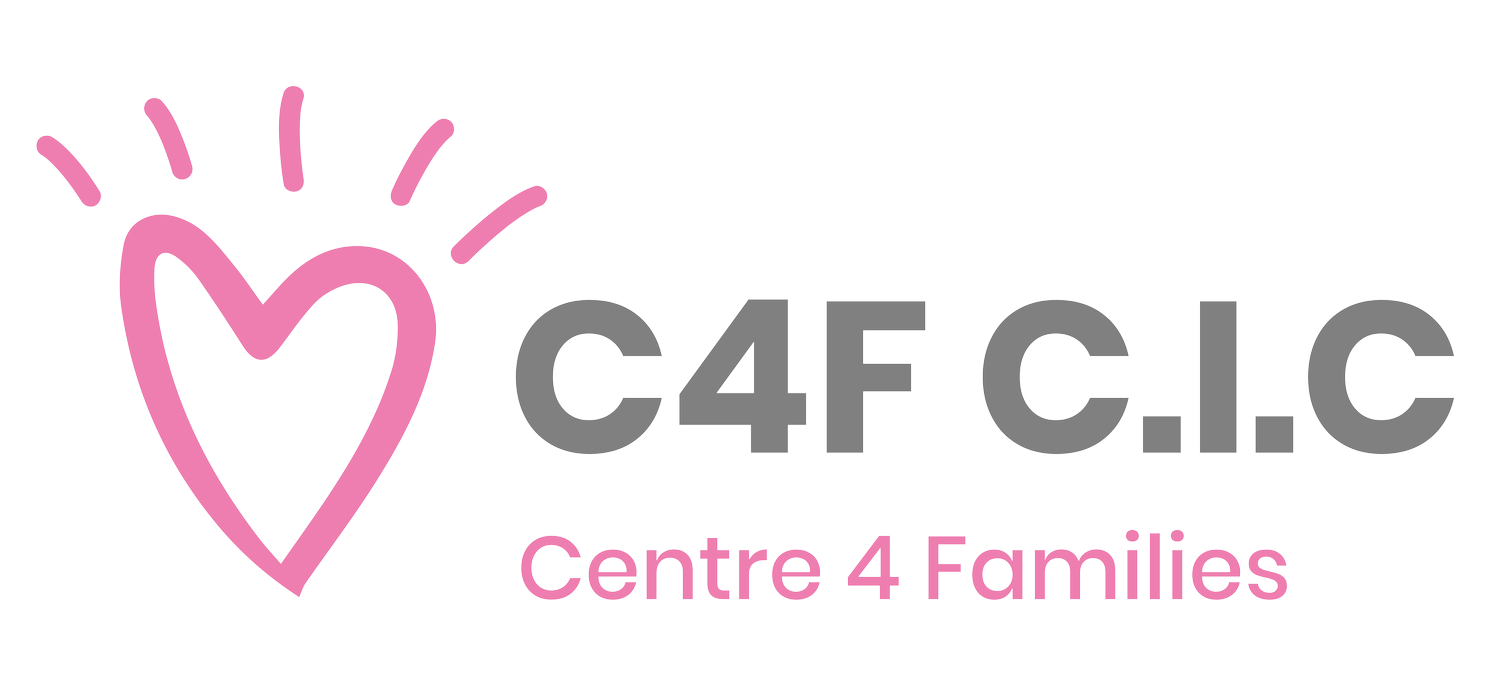Health & Safety Policy
C4F Child Contact Centre is committed to ensure the health, safety and welfare of its volunteers/staff and other persons who may be affected by our activities. We shall ensure that the requirements of the Health and Safety at Work etc. Act 1974 and other relevant statutory provisions are carried out so far as reasonably practicable. In particular we will so far as reasonably practicable, provide:
Premises which are well maintained in a safe condition.
Environments that are safe and without risk to health.
Equipment and systems of work that are safe and without risk to health.
Arrangements to identify and assess/minimise risk to paid/unpaid staff and others who may be affected by our activities.
Sufficient information, instruction, training and supervision to ensure the health and safety of paid/unpaid staff and others who may be affected by our activities.
Adequate facilities and arrangements to enable paid/unpaid to be consulted on any matter relating to their health, safety and welfare whilst at work.
The implementation of this policy will be regularly monitored to ensure that the objectives are being achieved. The policy will also be reviewed and if necessary revised to reflect any changes in organisational or legislative requirements
Organisation
Ultimate responsibility for health and safety lies with the Director who will ensure that adequate resources are made available to achieve the aims set out in this policy statement. The person responsible for the co-ordination of Health & Safety matters is Sam Bradley.
The successful implementation of this policy requires total commitment from all volunteers/staff within the organisation. Each individual has a legal obligation to take reasonable care of his or her own health and safety, and the safety of other people who may be affected by his or her acts
Health & Safety Responsibilities
Management Committee
Responsible for ensuring that this Health & Safety policy is followed by all paid/unpaid staff.
Responsible for approving any action recommended by risk assessments undertaken by the Centre Co-ordinator or Safety Officer.
Responsible for investigating any accidents with Centre Co-ordinator / Safety
Officers that have been reported under RIDDOR (Reporting of Injuries,Diseases and Dangerous Occurrences Regulations 1995).
Centre Co-ordinator / Safety Officer
Responsible for coordinating Health & Safety matters for the Organisation.
Responsibility for ensuring this policy is put into practice at the C4F.
Responsibility for carrying out a fire risk assessment and emergency procedures.
Responsibility for carrying out risk assessments as appropriate including an assessment into the risk associated with pushing and pulling of loads.
Responsibility for reporting the findings of all risk assessments to the Management Committee overseeing and who will also approve any action required to remove or control risks.
Responsibility for ensuring the action required is implemented and that these actions have removed or reduced the risks.
Responsibility for carrying out periodic formal active monitoring to check workplace precautions continue to work effectively.
Responsibility for reviewing risk assessments annually or when the work activity changes, whichever is soonest.
Responsibility for:
Management Committee
Centre Co-ordinator
Safety Officer
Centre Paid / Unpaid staff
I. identifying all machinery and equipment needing maintenance;
II. ensuring effective maintenance procedures are drawn up and are implemented;
III. ensuring that all identified maintenance is implemented.
Responsibility for checking that new machinery and equipment meets health and safety standards before it is purchased.
Responsibility for checking that new chemicals or substances can be used safely before they are purchased.
Responsibility for identifying all chemicals or substances that are a hazard and would require a risk assessment.
Responsibility for recording all accidents, incidents, near misses and cases of work-be related ill health in the accident book and for reporting accidents under RIDDOR – another staff member should be nominated for this in the absence of this person.
Responsibility for investigating accidents, incidents, near misses and cases of work related ill health for the Organisation following the investigation procedure and will act on findings to prevent a recurrence.
Responsibility for providing induction training for staff and consulting with staff on Health & Safety issues – this could be via an agenda item at staff meetings.
All Centre staff (including the staff mentioned above)
Responsibility for co-operating with supervisors on health and safety matters.
Responsibility for not interfering with anything provided to safeguard their health and safety.
Responsibility for taking reasonable care of their own health and safety, complying with any rules or regulations in place and any safe systems of work.
Responsibility for using equipment in accordance with instructions and training provided, not intentionally damaging or recklessly interfering with anything provided for the health and safety of themselves or others
Responsibility to check that workplace precautions continue to work effectively to reduce risk.
Responsibility for reporting on all health and safety concerns to the Centre Coordinator, Safety Officer or Management Committee as appropriate.
Responsibility for reporting any accidents, incidents, near misses and cases of work-related ill health to the Centre Co-ordinator / Safety Officer or alternative staff member if the nominated person is not available.
Responsibility for following regulations regarding security.
Responsibility for ensuring that any visitors and users of the Centre are made aware of emergency procedures and are supervised during an emergency evacuation.
Responsibility for undertaking training as required.
Any paid/unpaid staff failing to comply with these principles will be subject to disciplinary action, which could lead to dismissal.
Arrangements for Emergencies
Fire and evacuation
The Centre Co-ordinator / Safety Officer is responsible for ensuring that a fire risk assessment is undertaken and implemented for the Organisation. There is a fire procedure which all paid/unpaid staff and users of the Centre are made aware of, which takes into consideration the sensitive nature of a Contact session.
Emergency evacuation will be tested every 12 months. This is the responsibility of Sam Bradley
In the event of a fire, fire extinguishers should only be operated by a staff member who has been trained in their correct use.
Paid and unpaid staff must acquaint themselves with the locations of both Fire exits and Fire alarm points.
Paid and unpaid staff must participate in any fire drill.
Bomb alert
The Centre Coordinator is responsible for ensuring that a bomb alert risk assessment is undertaken and implemented for the Centre. This may involve setting an assembly point 100 metres from the Centre and opening all windows before evacuation.
Security of paid/unpaid staff and Centre users
The Centre Co-ordinator / Safety Officer is responsible for ensuring that a security risk assessment is undertaken and implemented for the Centre staff and Centre users.
The last person to leave the premises must ensure that the windows are closed, appliances and lights are switched off and doors are locked. Staff should request identification from any visitor that they do not recognise and appears suspicious and should call the police if unsure.
Accidents
First Aid box must be kept at the Centre. It will contain:
Assorted sterile adhesive dressings (plasters).
Medium sterile dressings.
Large sterile dressings.
Sterile eye pads.
Triangular bandages.
Safety pins.
Disposable gloves.
Advice leaflet.
Remember that there is no definitive list and each kit should reflect what it would be used for. For example, ensure that you have some small dressings and plasters if there is the possibility of using it for children.
The Health and Safety Checklist below is a useful reference tool to ensure the required standards are being met.
Are your service’s fire and emergency procedures clearly displayed, compliant with fire officer requirements and are staff and service users aware of them?
Do you keep an accurate record of who is in the building and who leaves the building?
Is there a named person to call the register in the event of a fire and the building being evacuated?
Are the fire extinguishers the correct type and in good working condition?
Are the fire extinguishers serviced annually?
Are staff aware of where fire extinguishers are located (and how to use them)?
Are the fire exits clearly labelled, kept closed, easily accessible and free from obstructions?
Are rubbish bins emptied daily
Is there a no smoking policy in the building?
Have you carried out a fire drill for staff in the previous 6 months?
Has your kettle, other earthed equipment and extension leads had a formal visual inspection in the last 6-12 months and a combined inspection and test in the last 1-2 years?
Building
Is the building or buildings suitable for that purpose and well maintained?
Do the building or buildings used for contact meet the relevant health and safety requirements and provide a safe and child centred environment?
Is your centre clean, well lit, ventilated and kept at an adequate temperature?
Are the furniture and furnishings within your centre in a suitable state of repaid and safe?
Do any of the floors have lifting/frayed carpets?
Unless they are in use, are steps and stairs fenced off?
Is it possible for children to open any of the windows?
Are all heaters well-guarded and kept away from children?
Are all parts of the centre used for preparing, serving or eating food, safe, clean, well maintained and inspected regularly?
Where food is either prepared or served, does the centre have the relevant food hygiene certificate?
Are the centre’s toilets and baby-changing facilities clean, safe, well maintained and inspected regularly?
Is any outside play area safe, secure, well maintained and inspected regularly?
Is the space available for the storage of equipment adequate and safe?
Are all cleaning products and disinfectants kept in a locked cupboard, in their original containers and stored out of sight and reach of the children?
Are the centre’s toilets and washbasins clean and easily accessible?
Is there safety glass in doors and are exposed windows guarded to an appropriate height?
Manual Handling
NB. There may be specific tasks, loads, issues with your working environment and an individual’s capacity that may also need to be considered
Have the staff involved in setting out the centre’s equipment and toys been trained in good lifting techniques?
Are staff encouraged to make large loads lighter or smaller by carrying smaller amounts for more journeys?
Is team handling used when it is not possible to reduce a large load?
Are trolleys/wheeled boxes available to make manual handling easier? Are these well maintained?
Toys
Are they inspected regularly, cleaned and free from sharp edges or pointed parts?
Are there soft areas adjacent to climbing frames and slides and is the equipment itself safe and free from rough edges or splinters?
Are climbing frames and swings erected properly and are they secured to the ground where required?
Have all of your bikes, tractors and pedal cars been serviced within the last 6 months?
First aid
Do you have a First Aid Kit? (it should not contain any medicine)
Is it both up to date and well stocked?
Does your centre have one or more named First-Aiders with Paediatric?
There must be a First Aider on each shift.
© EMERGENCY AID Reference Guide (St John Ambulance)
All accidents, incidents, near misses and cases of work-related ill health at any site are to be reported to the Centre Co-ordinator (or nominated person in the absence of the Centre Co-ordinator) and recorded on an accident form. The Centre Co-ordinator or other nominated person is responsible by law for reporting serious accidents, diseases and dangerous occurrences under RIDDOR.(See the Health and Safety Responsibilities section for duties relating to the investigation of accidents).


